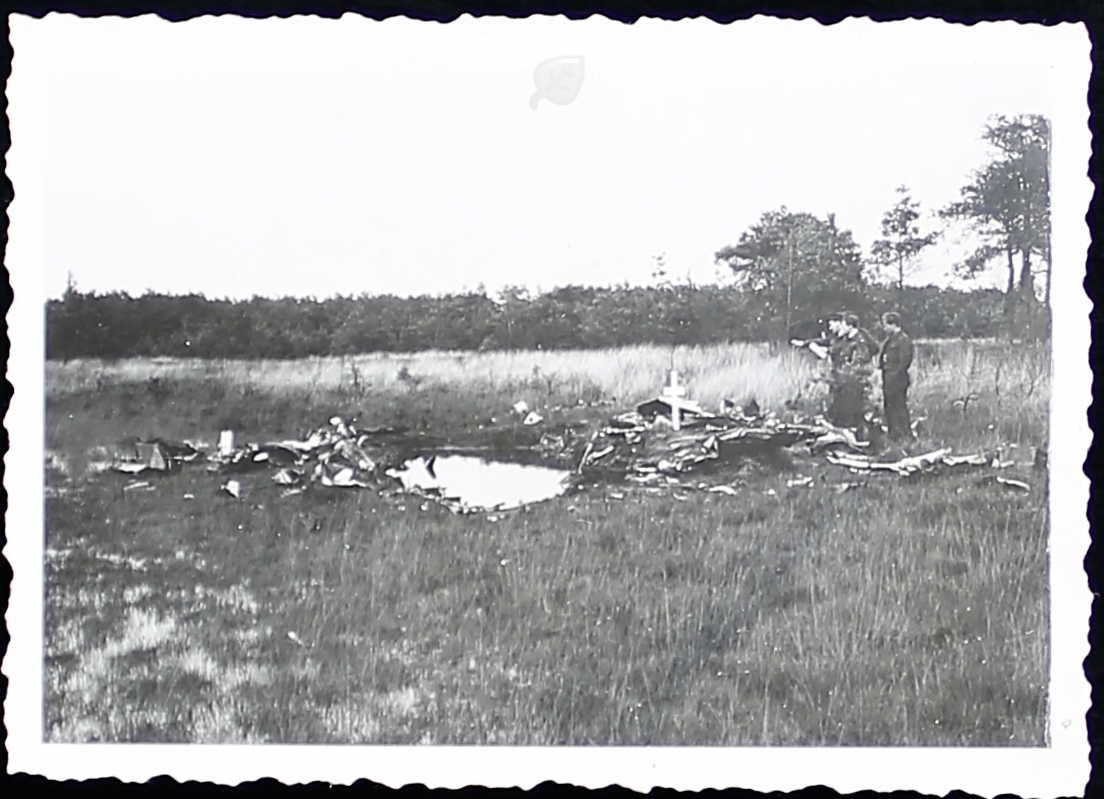
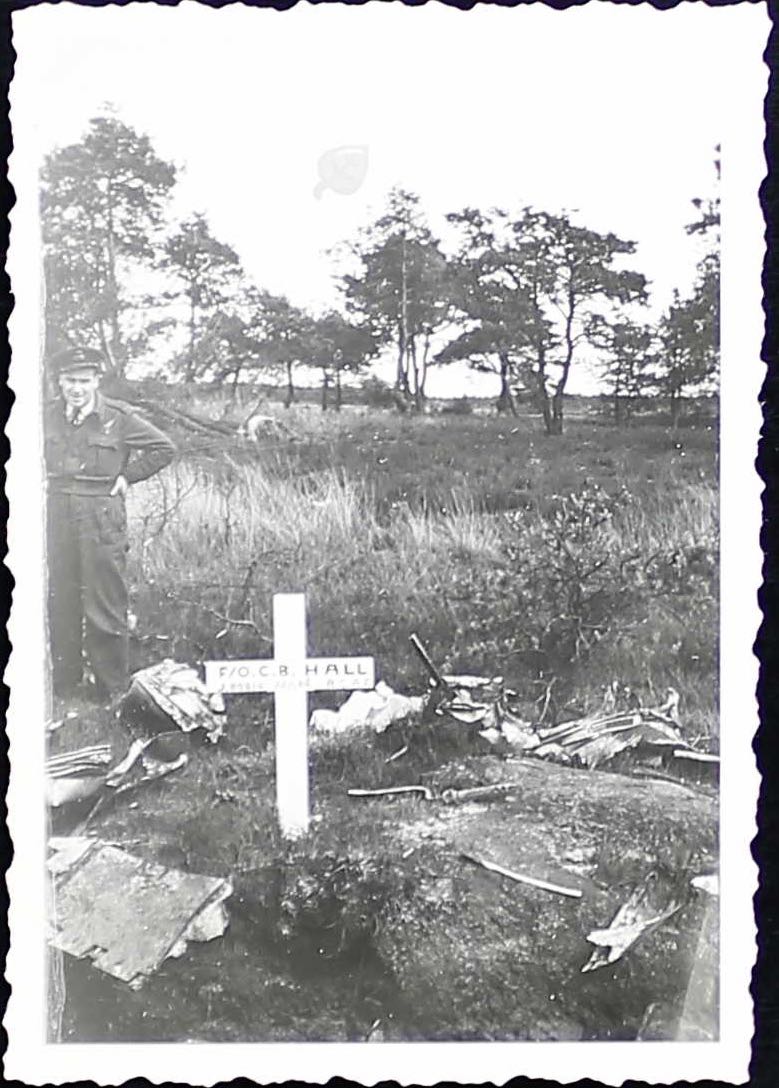
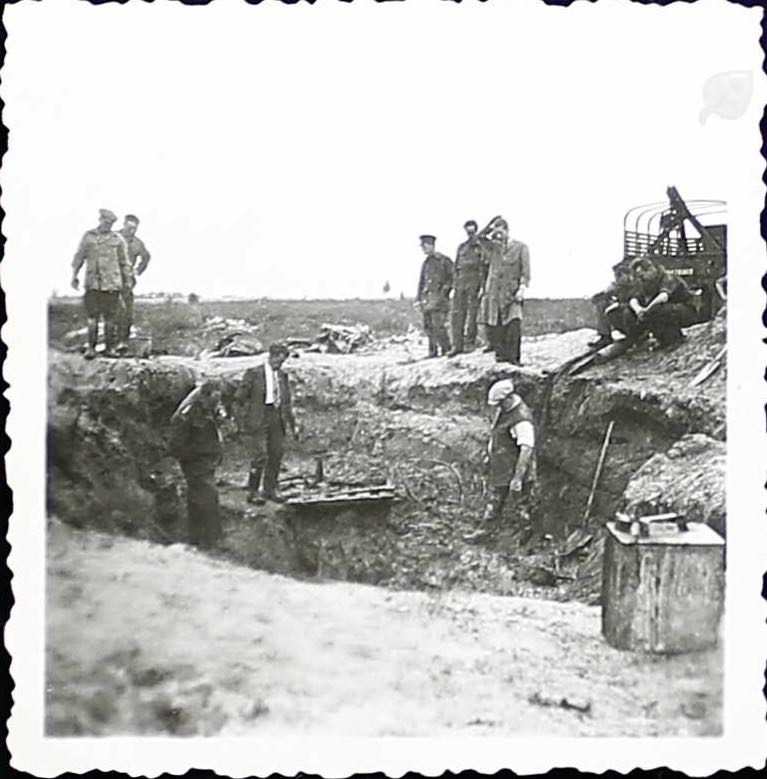
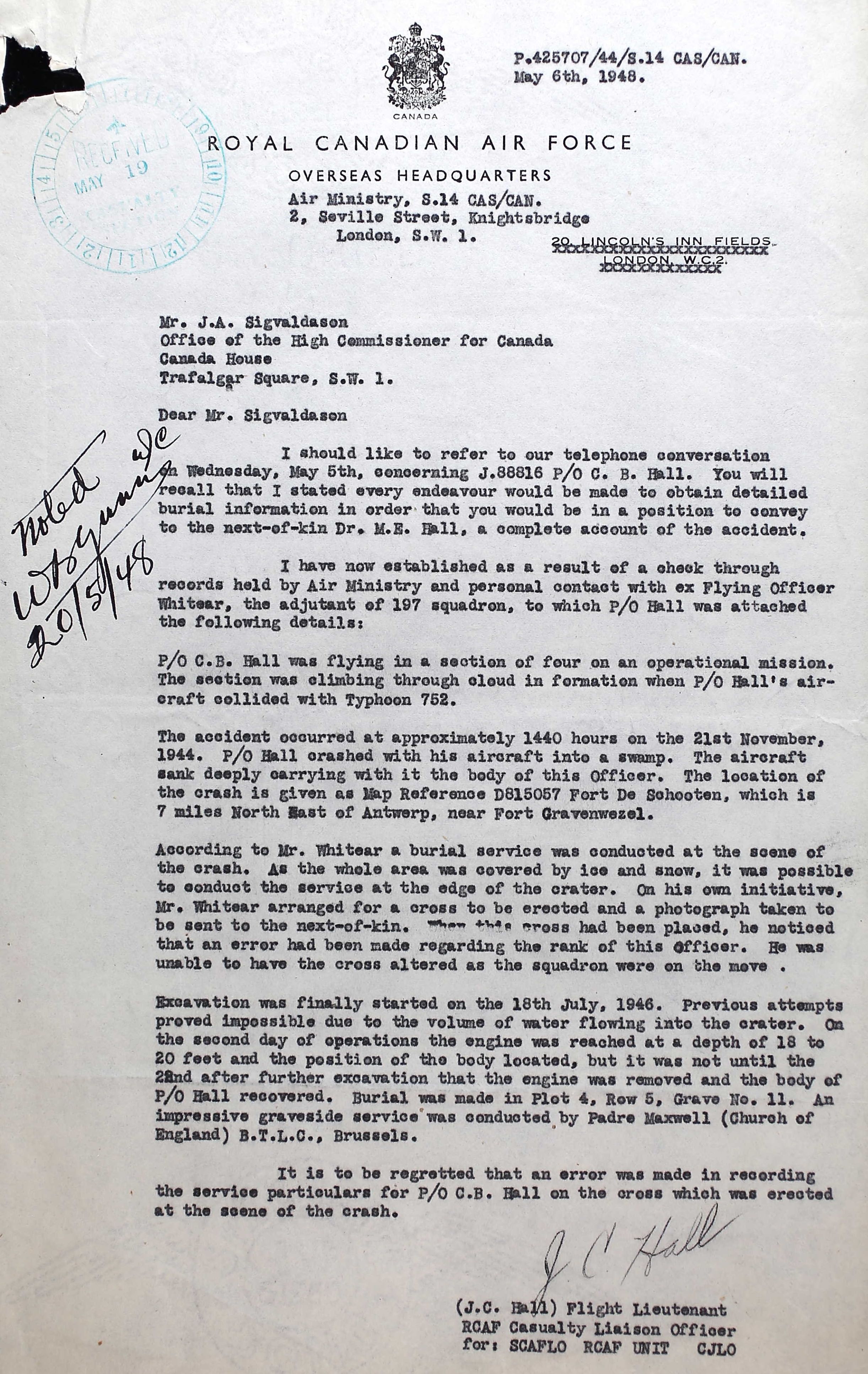
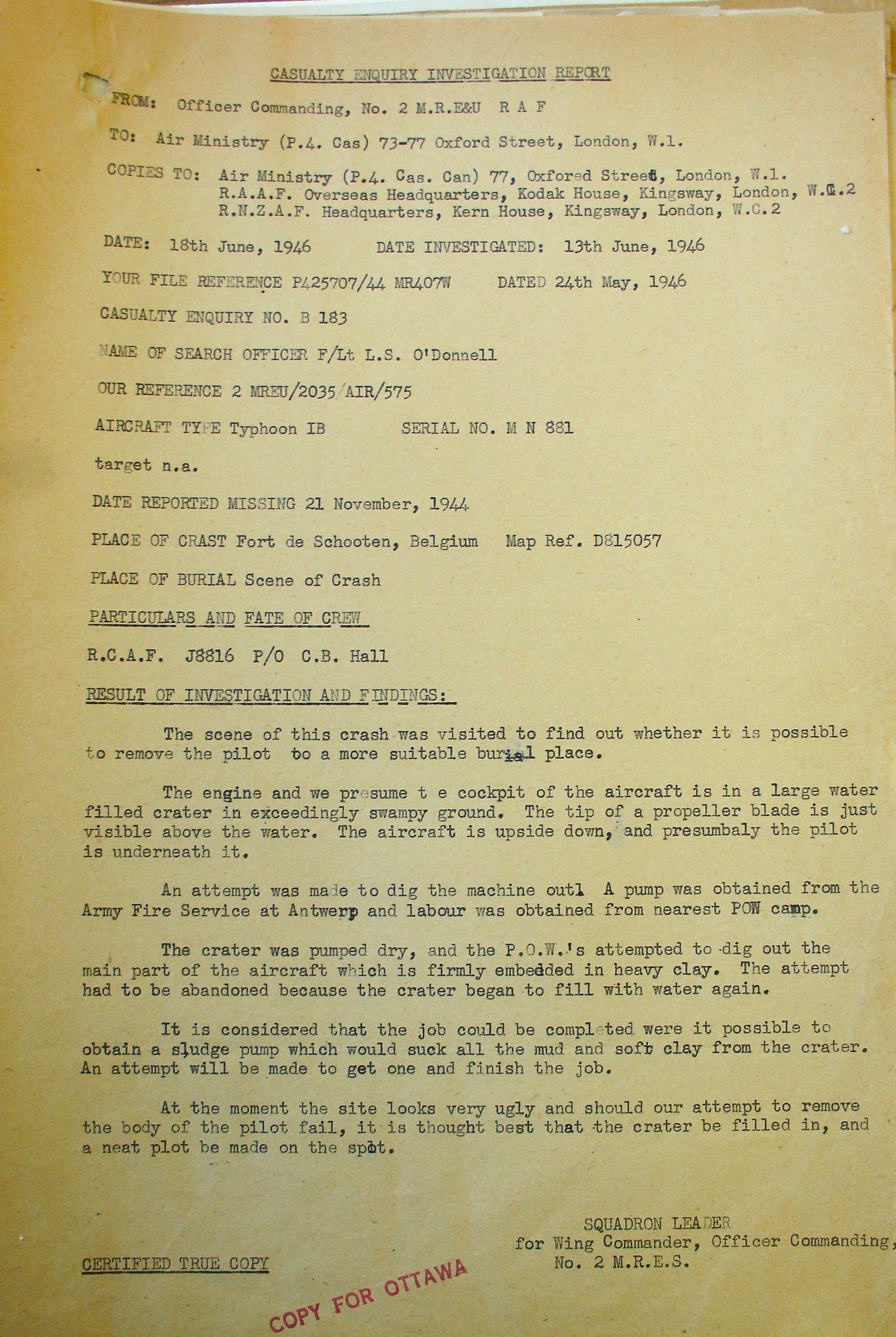
July 6, 1923 - November 21, 1944





Charles Burnham Hall, was the son of Dr. Morton Eldred (pathologist and WWI veteran) and Mrs. Eva Mae (nee Wilkinson) Hall of Edmonton, Alberta. He had three brothers, Capt. Morton Eldred Hall, Major Roger Montague Hall, and F/O Willard Samuel Hall (Charles's twin), and one sister, Frances Wilkinson Hall of Washington, DC. The family was Church of England.
Hall was a high school student prior to enlistment but also worked at Horne and Pitfield, a packing room, in the summer of 1941. He was assured a job at there after the war. He smoked 10 cigarettes daily, and drank alcohol occasionally. He liked rugby, hockey, extensively, baseball and basketball. He collected stamps as a hobby. He stood 5'5", weighed 126 pounds and had blue eyes and brown hair. In October 1941: "Diploma a little short on Geometry. Otherwise good marks. A well developed, keen, sincere candidate. Should make excellent airman. Recommend as pilot."
He was at No. 3 MD, Edmonton, December 1941 and then sent to Rockcliffe in February 1942, then to No. 5 MD Lachine for two months in 1942. He was at No. 3 ITS Victoriaville on April 12, 1942 [Quiet, sincere, steady, good natures. Alternative recommendation: WAG], then was sent to No. 17 EFTS Stanley, July 18, 1942 [Very slow as a student, needed pushing, sincere, no particular weakness]. He arrived at No. 14 SFTS Alymer, October 24, 1942, where he received his Pilot's Flying Badge on March 5, 1943. [Average student in all respects.]
Hall, after a trip to Halifax and across the Atlantic, found himself in England on March 27, 1943 at the RAF Trainees's Pool. Between June and July 1943, he was at 3 PRC: "59% Flying tests; 65% Character and Leadership. Not suitable at all for instructor. Just average ability. Tries hard. Will want to check dual before solo at night." At 17 AFU, between July and October 1943: "63.6% Ground Examinations, 55.7% Flying Tests, 55% Character and Leadership. An average and steady pilot, formation quite good. With a little more practice will make a good squadron pilot."
On November 21, 1944, P/O Hall was flying in a section of four on an operational mission [interdiction]. The section climbed through cloud in formation when P/O Hall's aircraft collided with Typhoon MN752 and both aircraft crashed north of base. Both P/O Hall and F/L E. K. Necklen, NZ40422 were killed. Hall had 84.15 hours on the Typhoon. Necklen had 100.50 hours on the Typhoon.
A Court of Inquiry was struck. "The accident occurred whilst the section of 4 Typhoons was flying through a thick bank of cloud, either just before or just after the section commenced to descent in cloud. The two aircraft concerned, No.'s 2 and 3, evidently collided. Owing to lack of witnesses of the actual mid-air collision, it is impossible to say what really happened. From the evidence of F/L COnnors, and from F/L Harding's statement that he saw movement to the starboard, it seems probable that P/O Hall, flying as No. 2 lost sight of his leader whilst in cloud; that he moved to starboard underneath his leader, and that he rammed from behind and below F/L Necklen's aircraft. It is quite impossible to say why P/O Hall might have lost sight of his leader in cloud. The evidence of his CO is that he was a competent cloud flyer. I consider that the leader of this formation, F/L Harding, is in no way to blame for the accident. He appears to have led his formation quite correctly and given suitable and well timed orders for the conditions of weather obtaining at the time." More from the Court of Inquiry can be found in the digitized files.
P/O Hall's aircraft, Typhoon 1B MN881, crashed in a very swampy area and made a crater which quickly filled with water. The aircraft was in 14 feet of water and with the ground too soft to permit any weight, no transport could get to the site. Although the area was covered by ice and snow, Hall's funeral was held at the edge of the crater, approximately seven miles north east of Antwerp, Belgium. Excavation was started on July 18, 1946 and on the second day, the engine was reached at a depth of 18-20 feet and the position of Hall's body located, but it was not until the 22nd that his body, along with the engine were removed. Another graveside service was conducted in Brussels in the Antwerp (Schoonselhof) Cemetery.
There had been some confusion as to Hall's rank. "It is possible that your son, at the time he lost his life, was not wearing his own tunic. This is known to have occurred, particularly among Fighter Pilots, who usually were sent out on missions with a minimum of warning. Any pilot on a Fighter Squadron would substantiate this. Your son was appointed to a Commission effective July 29, 1944 and lost his life November 21, 1944, not quite four months after. Promotion to Flying Officer would not be normal, and there never has been documentary evidence of promotion or contemplated promotion."
Hall was fondly known as Charlie to his squadron mates. W/C J. S. Harris, wrote to Hall's brother, Captain M. E. Hall, RCAMC, 29 British General Hospital, overseas, in December 1944. "We are often forced by our operational commitments to operate in very bad weather and it is then that these most unfortunate accidents are likely to occur. It seems that Charlie was killed instantly, probably by the explosion of the bombs and did not have a chance to bale out."
Dr. Hall was very persistent in getting details about his son's death. He scolded one person for writing to him as Mr. Hall. "There are many Mr. Morton Eldred Halls but only one Dr. Morton Eldred Hall," of which he received an apology. Dr. Hall wrote, "There have been many rumours of how glad the RAF were to have our personnel but beyond that gave little attention. Have we no personnel officers who constantly watch over these lads of 18-21 who go into the RAF?"
In Hall's Service Pay Book, he had Cathie Sullivan's phone number.
LINKS: